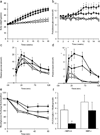Improved glycaemia in high-fat-fed neprilysin-deficient mice is associated with reduced DPP-4 activity and increased active GLP-1 levels
- PMID: 27933334
- PMCID: PMC5342915
- DOI: 10.1007/s00125-016-4172-4
Improved glycaemia in high-fat-fed neprilysin-deficient mice is associated with reduced DPP-4 activity and increased active GLP-1 levels
Abstract
Aim/hypothesis: Neprilysin, a widely expressed peptidase, is upregulated in metabolically altered states such as obesity and type 2 diabetes. Like dipeptidyl peptidase-4 (DPP-4), neprilysin can degrade and inactivate the insulinotropic peptide glucagon-like peptide-1 (GLP-1). Thus, we investigated whether neprilysin deficiency enhances active GLP-1 levels and improves glycaemia in a mouse model of high fat feeding.
Methods: Nep +/+ and Nep -/- mice were fed a 60% fat diet for 16 weeks, after which active GLP-1 and DPP-4 activity levels were measured, as were glucose, insulin and C-peptide levels during an OGTT. Insulin sensitivity was assessed using an insulin tolerance test.
Results: High-fat-fed Nep -/- mice exhibited elevated active GLP-1 levels (5.8 ± 1.1 vs 3.5 ± 0.8 pmol/l, p < 0.05) in association with improved glucose tolerance, insulin sensitivity and beta cell function compared with high-fat-fed Nep +/+ mice. In addition, plasma DPP-4 activity was lower in high-fat-fed Nep -/- mice (7.4 ± 1.0 vs 10.7 ± 1.3 nmol ml-1 min-1, p < 0.05). No difference in insulin:C-peptide ratio was observed between Nep -/- and Nep +/+ mice, suggesting that improved glycaemia does not result from changes in insulin clearance.
Conclusions/interpretation: Under conditions of increased dietary fat, an improved glycaemic status in neprilysin-deficient mice is associated with elevated active GLP-1 levels, reduced plasma DPP-4 activity and improved beta cell function. Thus, neprilysin inhibition may be a novel treatment strategy for type 2 diabetes.
Keywords: DPP-4; GLP-1; Glucose tolerance; High fat diet; Insulin secretion; Mme; Mouse; Nep; Neprilysin.
Conflict of interest statement
The authors declare that there is no conflict of interest associated with this manuscript.
Figures



References
-
- Muangman P, Spenny ML, Tamura RN, Gibran NS. Fatty acids and glucose increase neutral endopeptidase activity in human microvascular endothelial cells. Shock. 2003;19:508–512. - PubMed
-
- Antezana M, Sullivan S, Usui M, et al. Neutral endopeptidase activity is increased in the skin of subjects with diabetic ulcers. J Invest Dermatol. 2002;119:1400–1404. - PubMed
Publication types
MeSH terms
Substances
Grants and funding
LinkOut - more resources
Full Text Sources
Other Literature Sources
Medical
Molecular Biology Databases
Miscellaneous

